Related Research Articles
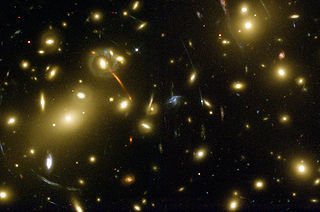
Abell 2218 is a large cluster of galaxies over 2 billion light-years away in the constellation Draco.

Abell 1835 IR1916 was a candidate for being the most distant galaxy ever observed, although that claim has not been verified by additional observations. It was claimed to lie behind the galaxy cluster Abell 1835, in the Virgo constellation.

Abell 1835 is a galaxy cluster in the Abell catalogue. It is a cluster that also gravitational lenses more-distant background galaxies to make them visible to astronomers. The cluster has a red shift of around 75,900 km/s and spans 12′.
Abell 754 is a galaxy cluster in the constellation Hydra that was formed from the collision of two smaller clusters. This collision, which began about 300 million years ago, is ongoing, and the system is still disturbed. Eventually, the cluster will reach a level of equilibrium in a few billion years.

Abell 2029 or A2029 is a large and relaxed cluster of galaxies 315 megaparsecs away in the constellation Virgo. A2029 is a Bautz–Morgan classification type I cluster due to its large central galaxy, IC 1101. Abell 2029 has a diameter of 5.8–8 million light-years. This type of galaxy is called a cD-type brightest cluster galaxy and may have grown to its large size by accreting nearby galaxies. Despite its relaxed state, it is the central member of a large supercluster which shows clear signs of interaction.
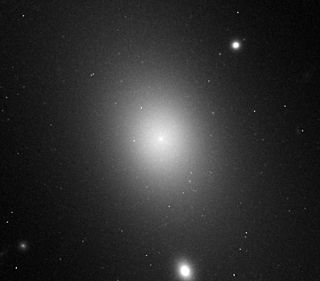
IC 1101 is a class S0 supergiant (cD) lenticular galaxy at the center of the Abell 2029 galaxy cluster. It has an isophotal diameter at about 123.65 to 169.61 kiloparsecs. It possesses a diffuse core which is the largest known core of any galaxy to date, and also hosts a supermassive black hole that is one of the largest black holes known. The galaxy is located at 354.0 megaparsecs from Earth. The galaxy was discovered on 19 June 1790, by the British astronomer William Herschel.

Abell 1689 is a galaxy cluster in the constellation Virgo over 2.3 billion light-years away.
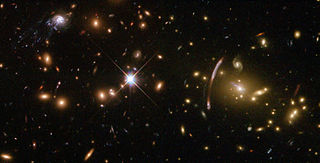
Abell 2667 is a galaxy cluster. It is one of the most luminous galaxy clusters in the X-ray waveband known at a redshift about 0.2.
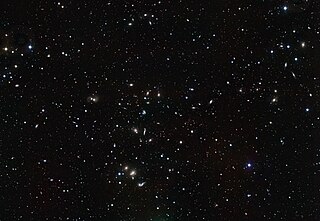
The Hercules Cluster is a cluster of about 200 galaxies some 500 million light-years distant in the constellation Hercules. It is rich in spiral galaxies and shows many interacting galaxies. The cluster is part of the larger Hercules Supercluster, which is itself part of the much larger Great Wall super-structure.

The Leo Cluster is a galaxy cluster about 330 million light-years distant in the constellation Leo, with at least 70 major galaxies. The galaxy known as NGC 3842 is the brightest member of this cluster. Along with the Coma Cluster, it is one of the two major clusters comprising the Coma Supercluster, which in turn is part of the CfA2 Great Wall, which is hundreds of millions light years long and is one of the largest known structures in the universe.

Abell 2142, or A2142, is a huge, X-ray luminous galaxy cluster in the constellation Corona Borealis. It is the result of a still ongoing merger between two galaxy clusters. The combined cluster is six million light years across, contains hundreds of galaxies and enough gas to make a thousand more. It is "one of the most massive objects in the universe."
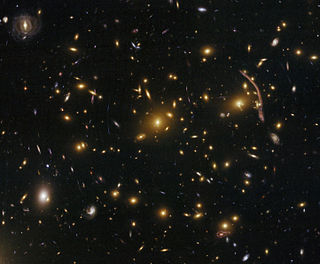
Abell 370 is a galaxy cluster located nearly 5 billion light-years away from the Earth, in the constellation Cetus. Its core is made up of several hundred galaxies. It was catalogued by George Abell, and is the most distant of the clusters he catalogued.

Abell 2744, nicknamed Pandora's Cluster, is a giant galaxy cluster resulting from the simultaneous pile-up of at least four separate, smaller galaxy clusters that took place over a span of 350 million years, and is located approximately 4 billion light years from Earth. The galaxies in the cluster make up less than five percent of its mass. The gas is so hot that it shines only in X-rays. Dark matter makes up around 75 percent of the cluster's mass.

Abell 1413 is a massive and rich type I galaxy cluster straddling the border between the constellations Leo and Coma Berenices, with the projected comoving distance of approximately 640 Mpc (2.1 billion ly). The cluster is especially notable due to the presence of its very large brightest cluster galaxy (BCG), one of the most extreme examples of its type, as well as one of the largest galaxies known. The cluster was first noted by George O. Abell in 1958.
Abell 222 is a galaxy cluster in the constellation of Cetus. It holds thousands of galaxies together. It is located at a distance of 2.4 billion light-years from Earth.
Abell 223 is a galaxy cluster. It is located at a distance of 2.4 billion light-years from Earth. The cluster is connected to nearby cluster Abell 222 by a filament of matter. Research has shown that only 20% of that matter is normal. The rest is thought to be dark matter. This means that this would form the Abell 222/ Abell 223 Supercluster as we understand them.

Abell 2597 is a galaxy cluster located about a billion light years from Earth in the constellation of Aquarius. It is a giant elliptical galaxy that is surrounded by a sprawling cluster of other galaxies. In 2018, the National Radio Astronomy Observatory (NRAO) captured cosmic weather event using the Atacama Large Millimeter/submillimeter Array (ALMA) that has never been seen before - a cluster of towering intergalactic gas clouds raining in on the supermassive black hole at the center of the huge galaxy. The black hole draws in vast store of cold molecular gas and sprays it back again in an ongoing cycle so that it resembles a gigantic fountain.

Abell 3412 is a galaxy cluster in the constellation Hydra. It is located about two billion light-years from Earth and weighs about a million billion times the mass of the Sun.

ESO 444-46 is a class E4 supergiant elliptical galaxy; the dominant and brightest member of the Abell 3558 galaxy cluster around 640 million light-years away in the constellation Centaurus. It lies within the core of the massive Shapley Supercluster, one of the closest neighboring superclusters. It is one of the largest galaxies in the local universe, and possibly contains one of the most massive black holes known. The black hole's mass is very uncertain, with estimates ranging from as low as 501 million M☉, to as high as 77.6 billion M☉.
Abell 1146 is a rich galaxy cluster in the constellation Crater. Its richness class is 4, and it is located about 2 billion light-years away.
References
- 1 2 3 "Astronomers Discover Powerful Cosmic Double Whammy". chandra.harvard.edu. NASA . Retrieved 7 January 2017.
- 1 2 3 "ACO 3411". SIMBAD . Centre de données astronomiques de Strasbourg . Retrieved 3 April 2019.
- 1 2 Abell, George O.; Corwin, Harold G. Jr.; Olowin, Ronald P. (1989). "A catalog of rich clusters of galaxies". The Astrophysical Journal Supplement Series. 70: 1. Bibcode:1989ApJS...70....1A. doi: 10.1086/191333 .